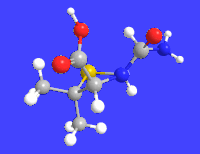This is the current revision of this page, as edited by CrafterNova (talk | contribs) at 03:59, 4 March 2024 (no use of semi-colon (;) here). The present address (URL) is a permanent link to this version.
Revision as of 03:59, 4 March 2024 by CrafterNova (talk | contribs) (no use of semi-colon (;) here)(diff) ← Previous revision | Latest revision (diff) | Newer revision → (diff)
| |

| |
| Names | |
|---|---|
| IUPAC name 6β-Amino-2,2-dimethylpenam-3α-carboxylic acid | |
| Systematic IUPAC name (2S,5R,6R)-6-Amino-3,3-dimethyl-7-oxo-4-thia-1-azabicycloheptane-2-carboxylic acid | |
| Identifiers | |
| CAS Number | |
| 3D model (JSmol) | |
| ChEBI | |
| ChemSpider | |
| ECHA InfoCard | 100.008.177 |
| EC Number |
|
| PubChem CID | |
| UNII | |
| CompTox Dashboard (EPA) | |
InChI
| |
SMILES
| |
| Properties | |
| Chemical formula | C8H12N2O3S |
| Molar mass | 216.26 g·mol |
| Appearance | colourless |
| Melting point | 198 °C (388 °F; 471 K) |
| Solubility in water | 0.4 g/100 mL |
| log P | 0.600 |
| Except where otherwise noted, data are given for materials in their standard state (at 25 °C , 100 kPa).
| |
6-APA ((+)-6-aminopenicillanic acid) is a chemical compound used as an intermediate in the synthesis of β–lactam antibiotics. The major commercial source of 6-APA is still natural penicillin G. The semi-synthetic penicillins derived from 6-APA are also referred to as penicillins and are considered part of the penicillin family of antibiotics.
In 1958, Beecham scientists from Brockham Park, Surrey, found a way to obtain 6-APA from penicillin. Other β-lactam antibiotics could then be synthesized by attaching various side-chains to the nucleus. The reason why this was achieved so many years after the commercial development of penicillin by Howard Florey and Ernst Chain lies in the fact that penicillin itself is very susceptible to hydrolysis, so direct replacement of the side-chain was not a practical route to other β-lactam antibiotics.
References
- Patrick GL (2017). Medicinal Chemistry (6th ed.). Oxford, UK: Oxford University Press. p. 425. ISBN 978-0198749691.
- Batchelor, F. R.; Doyle, F. P.; Nayler, J. H. C.; Rolinson, G. N. (1959). "Synthesis of Penicillin: 6-Aminopenicillanic Acid in Penicillin Fermentations". Nature. 183 (4656): 257–258. Bibcode:1959Natur.183..257B. doi:10.1038/183257b0. PMID 13622762. S2CID 4268993.
- F.P. Doyle, J.H.C. Nayler, G.N. Rolinson US Patent 2,941,995, filed July 22, 1958, granted June 21, 1960. Recovery of solid 6-aminopenicillanic acid.